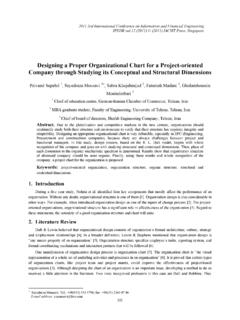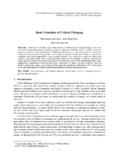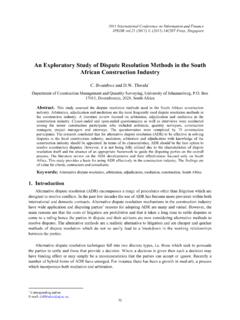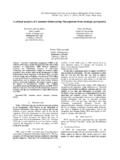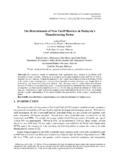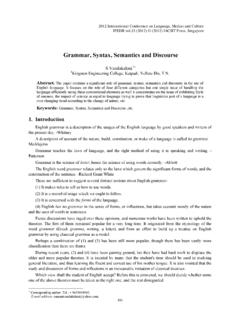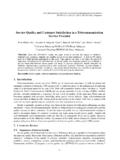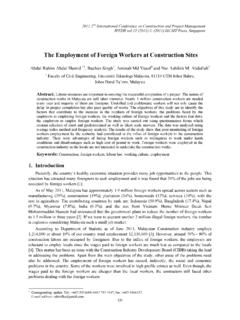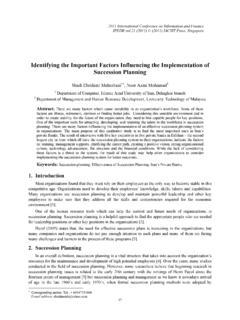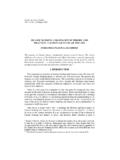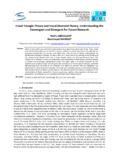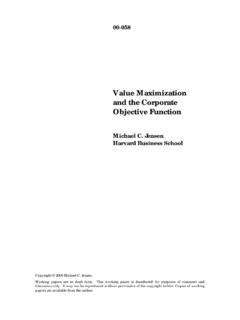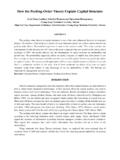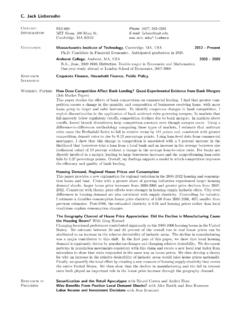Transcription of A Literature Review of Corporate Governance - IPEDR
1 A Literature Review of Corporate Governance Humera Khan+ Faculty of Management Sciences COMSATS Institute of Information Technology Islamabad Abstract. Corporate Governance is a broad term defines the methods, structure and the processes of a company in which the business and affairs of the company managed and directed. Corporate Governance also enhances the long term shareholder value by the process of accountability of managers and by enhances the firm s performance. It also eliminate the conflict of ownership and control by separately defines the interest of shareholders and managers. This paper reviews the extensive Literature of Corporate Governance practices to find out the effectiveness of Corporate Governance mechanism in the companies and institutions.
2 The paper also focuses on to reduce the principal-agent problem due to the effective Corporate Governance mechanism in the organizations. Keywords: Corporate Governance , agency theory, ownership, shareholders, managers. 1. Introduction Corporate Governance is the broad term desribes the processes, customs, policies, laws and institutions that directs the organizations and corporations in the way they act, administer and controll their works to achieve the goal of the organization and manages the relationship among the stakeholders including the board of directors and the also deals with the accountability of the individuals through a mechanism which reduces the principal-agent problem in the organization. Fine Corporate Governance is an essential standard for establishing the striking investment environment which is needed by competitive companies to gain strong position in efficient financial markets.
3 Good Corporate Governance is fundamental to the economies with extensive business background and also facilitates the success for entrepreneurship. During the last two decades the research area in finance is primarily focus on the area of Corporate Governance . The separation of ownership from control is the core of the agency problems facing by the firms (Berle & Means 1932; Jensen & Meckling 1976). This leads to many issues related to efficient control for the assets of corporations in the interest of all company s stakeholders. A great research has been done in the area of Corporate Governance by keeping the agency related problem. Core (1999) firms who have weaker Governance to direct and manage company matter face greater agency problems.
4 The agency problem allows manager to extract more private benefits and the firm ultimately performs worse. Firms therefore, needed for the improved Corporate Governance in order to survive for long term growth and survival. A good Corporate Governance can occur in the organization by putting the balance between the ownership and control and also among the interests of stakeholders of the firm. This approach might be helpful in developing the positive attitude among the manager and shareholders and reduces the agency problems in the paper presents the broad view of Corporate Governance from various perspectives and tries to link it with the agency problems where required. It gives an overview that how Corporate Governance handles the deviation between the mangers and shareholders interests.
5 The mechanism of effective Corporate Governance will help to determine the difference between ownership and control by giving the view of topic from different angles and tries to solve the agency problems in the organizations. 2. Literature Review of Corporate Governance + E-mail address: 12011 International Conference on E-business, Management and Economics IPEDR (2011) (2011)IACSIT Press, Singapore Corporate Governance importance arises in modern corporations due to the separation of management and ownership control in the organizations. The interests of shareholders are conflicting with the interests of managers. The principal agent problem is reflected in the management and direction related problems due to the differential interests of firm s stakeholders.
6 There is not a single definition of Corporate Governance rather it might be viewed from different angles. Berle and Means (1932) and the even earlier Smith (1776). Zingales (1998) defines Corporate Governance as allocation of ownership, capital structure, managerial incentive schemes, takeovers, board of directors, pressure from institutional investors, product market competition, labour market competition, organisational structure, etc., can all be thought of as institutions that affect the process through which quasi-rents are distributed (p. 4) . Garvey and Swan (1994) assert that Governance determines how the firm s top decision makers (executives) actually administer such contracts (p. 139) . Shleifer and Vishny (1997) define Corporate Governance as the ways in which suppliers of finance to corporations assure themselves of getting a return on their investment ( ).
7 OECD in 1999 defined Corporate Governance as " Corporate Governance is the system by which business corporations are directed and controlled. The Corporate Governance structure specifies the distribution of rights and responsibilities among different participants in the corporation, such as, the board, managers, shareholders and other stakeholders, and spells out the rules and procedures for making decisions on Corporate affairs. By doing this, it also provides the structure through which the company objectives are set, and the means of attaining those objectives and monitoring performance. Oman (2001) defined Corporate Governance as a term refers to the private and public institutions that include laws, regulations and the business practices which governs the relationship between the Corporate managers and the Ministry of Finance, Singapore ( Corporate GOVERNANCEC 2001) defines Corporate Governance as the processes and structure by which the business and affairs of the company are directed and managed, in order to enhance long term shareholder value through enhancing Corporate performance and accountability, whilst taking into account the interests of other stakeholders.
8 Good Corporate Governance therefore embodies both enterprise (performance) and accountability (conformance). (Fin, 2004, pp 13-14). La Porta, Silanes and Shliefer (2000, 2002) view Corporate Governance as a set of mechanisms through which outside investors (shareholders) protect themselves from inside investors (managers). The Organization for Economic Cooperation and Development provides another perspective by stating that Corporate Governance is the system by which business corporations are directed and controlled. The Corporate Governance structure specifies the distribution of rights and responsibilities among different participants inthe corporation, such as the Board, managers, shareholders and other stakeholders, and spells out the rules and procedure for making decisions on Corporate affairs.
9 By doing this, it also provides the structures through which the company objectives are set, and the means of attaining those objectives and monitoring performance. 3. A View from Literature of Corporate Governance & Agency Theory McColgan (2001) gave a very broader view of agency theory and Corporate Governance . The major interest of his research was to cover the area that where the interests of managers diverge from those of the interests of shareholders. He kept in view the agency relationship and the agency cost which arises from these relationships. He extended the work of Jensen and Meckling (1976) who defined the agency relationship as a type of contract in which the principal keep the agent to carry out the services of the firm on his behalf.
10 The agency problem arises due to the different interest and the conflict between the ownership and control as principal delegate some decision making authority to the agent. Jensen and Meckling (1976) argued that this delegation authority reduces the value maximizing decisions taking by the manager in the firm. Himmelberg,, Hubbard and Palia. (1999), argued Jenson and Meckling (1976) by saying that principal agent problem are not similar in all firms rather they are different in different firms, different industries and also in different cultures. Himmelberg et al. (1999) said that Jenson original theory nexus of contract suggest the same. McColgan (2001) agreeing with the authors said that agency problem can be reduces by the help of effective Corporate Governance mechanism which can be important in reducing the agency cost and the ownership problems in the firms.
